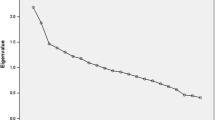Abstract
Objectives: Oral epithelial dysplasia (OED) is a histopathologic diagnosis associated with an increased risk of oral cancer. The paper explores the relationship between OED risk and food group intake.
Methods: In this case–control study, incident cases of OED were identified through two oral pathology laboratories. Controls, pair-matched 1:1 to cases on age ( ± 5 years), gender, appointment date ( ± 1 year), and surgeon, were identified through the office in which the respective case was biopsied. Exposure data were obtained via a telephone interview and mailed food-frequency questionnaire. cConditional logistic regression was used to obtain odds ratio point estimates.
Results: Based upon 87 matched pairs – and after controlling for smoking, drinking, and other potential covariates–there was an apparent inverse relationship between OED risk and the consumption of fruits and vegetables, with the intake of these foods being associated with a strong attenuating effect among smokers. OED risk decreased with increased poultry consumption, but increased modestly with bread/cereal and dairy food intake.
Conclusions: This investigation provides evidence that some aspects of diet may be associated with the risk of OED. It also suggests that in oral carcinogenesis the role of diet is not simply one of a late effect.
Similar content being viewed by others
References
Blot WJ, McLaughlin JK, Winn DM et al. (1988) Smoking and drinking in relation to oral and pharyngeal cancer. Cancer Res 48: 3282–3287.
Winn DM (1995) Diet and nutrition in the etiology of oral cancer. Am J Clin Nutr 61 (Suppl.): 437S–445S.
Marshall JR, Boyle P (1996) Nutrition and oral cancer. Cancer Causes Control 7: 101–111.
WHO Collaborating Centre for Oral Precancerous Lesions (1978) Definition of leukoplakia and related lesions: an aid to studies on oral precancer. Oral Surg 46: 518–539.
Kramer IRH (1980) Basic histopathological features of oral premalignant lesions. In: Mackensie IC, Dabelsteen E, Squier CA, eds. Oral Premalignancy. Proceedings of the First Dows Symposium. Iowa City, IA: University of Iowa Press, pp. 23–34.
Silverman S, Jr, Gorsky M, Lozada F (1984) Oral leukoplakia and malignant transformation: a follow-up study of 257 patients. Cancer 53: 563–568.
Lumerman H, Freedman P, Kerpel S (1995) Oral epithelial dysplasia and the development of invasive squamous cell carcinoma. Oral Surg Oral Med Oral Pathol Oral Radiol Endod 79: 321–329.
Morse DE, Katz RV, Pendrys DG et al. (1996) Smoking and drinking in relation to oral epithelial dysplasia. Cancer Epidemiol Biomarkers Prev 5: 769–777.
Morse DE, Katz RV, Pendrys DG et al. (1997) Mouthwash use and dentures in relation to oral epithelial dysplasia. Oral Oncol 33: 338–343.
Abbey LM, Kaugars GE, Gunsolley JC et al. (1995) Intraexaminer and interexaminer reliability in the diagnosis of oral epithelial dysplasia. Oral Surg Oral Med Oral Pathol Oral Radiol Endod 80: 188–191.
Pindborg JJ, Reibel J, Holmstrup P (1985) Subjectivity in evaluating oral epithelial dysplasia, carcinoma in situ and initial carcinoma. J Oral Pathol 14: 698–708.
Willett WC, Sampson L, Brown ML et al. (1988) The use of a self-administered questionnaire to assess diet four years in the past. Am J Epidemiol 127: 188–199.
Rimm EB, Giovannucci EL, Stampfer MJ, Colditz GA, Litin LB, Willett WC (1992) Reproducibility and validity of an expanded self-administered semiquantitative food frequency questionnaire among male health professionals. Am J Epidemiol 135: 1114–1126.
Feskanich D, Rimm EB, Giovannucci EL et al. (1993) Reproducibility and validity of food intake measurements from a semiquantitative food frequency questionnaire. J Am Diet Assoc 93: 790–796.
Breslow NE, Day NE (1980) Statistical Methods in Cancer Research, vol. I: The Analysis of Case-Control Studies. Lyon: IARC, pp. 248–279.
McLaughlin JK, Gridley G, Block G et al. (1988) Dietary factors in oral and pharyngeal cancer. J Natl Cancer Inst 80: 1237–1243.
Franco EL, Kowalski LP, Oliveira BV et al. (1989) Risk factors for oral cancer in Brazil: a case-control study. Int J Cancer 43: 992–1000.
Franceschi S, Bidoli E, Barón AE et al. (1991) Nutrition and cancer of the oral cavity and pharynx in north-east Italy. Int J Cancer 47: 20–25.
La Vecchia C, Negri E, D'Avanzo B, Boyle P, Franceschi S (1991) Dietary indicators of oral and pharyngeal cancer. Int J Epidemiol 20: 39–44.
Zheng W, Blot WJ, Shu X-O et al. (1992) Risk factors for oral and pharyngeal cancer in Shanghai, with emphasis on diet. Cancer Epidemiol Biomarkers Prev 1: 441–448.
Zheng T, Boyle P, Willett WC et al. (1993) A case-control study of oral cancer in Beijing, People's Republic of China. Associations with nutrient intakes, foods and food groups. Oral Oncol 29B: 45–55.
Levi F, Pasche C, La Vecchia C, Lucchini F, Franceschi S, Monnier P (1998) Food groups and risk of oral and pharyngeal cancer. Int J Cancer 77: 705–709.
Gupta PC, Hebert JR, Bhonsle RB, Murti PR, Mehta H, Mehta FS (1999) Influence of dietary factors on oral precancerous lesion in a population-based case-control study in Kerala, India. Cancer 85: 1885–1893.
Block G, Hartman AM, Naughton D (1990) A reduced dietary questionnaire: development and validation. Epidemiology 1: 58–64.
Winn DM, Ziegler RG, Pickle LW, Gridley G, Blot WJ, Hoover RN (1984) Diet in the etiology of oral and pharyngeal cancer among women from the southern United States. Cancer Res 44: 1216–1222.
Gridley G, McLaughlin JK, Block G et al. (1990) Diet and oral and pharyngeal cancer among blacks. Nutr Cancer 14: 219–225.
Franceschi S, Barra S, La Vecchia C, Bidoli E, Negri E, Talamini R (1992) Risk factors for cancer of the tongue and the mouth. A case-control study from Northern Italy. Cancer 70: 2227–2233.
Author information
Authors and Affiliations
Rights and permissions
About this article
Cite this article
Morse, D.E., Pendrys, D.G., Katz, R.V. et al. Food group intake and the risk of oral epithelial dysplasia in a United States population. Cancer Causes Control 11, 713–720 (2000). https://doi.org/10.1023/A:1008943904085
Issue Date:
DOI: https://doi.org/10.1023/A:1008943904085




